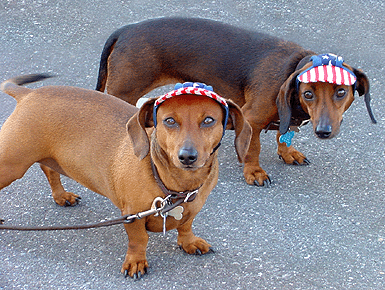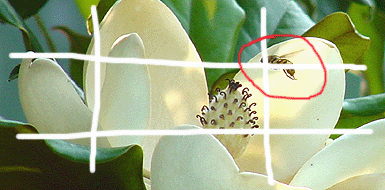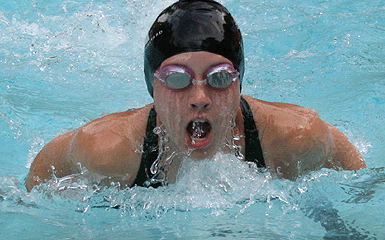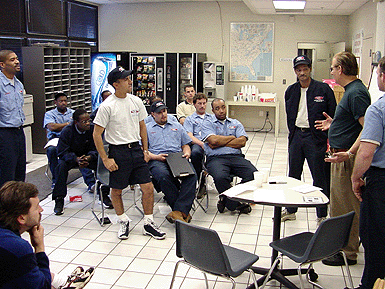|
This issue is sponsored by marbles, hopscotch, kick the can, and hide and seek.
|
|
|
|
|
|
|
|
|
|
|
Add interest to your photos by lining off an imaginary Tic Tac Toe game on your camera’s viewfinder, dividing it into thirds both horizontally and vertically. Then place the main object at one of four points created by the intersecting lines rather than in the center.
|
|
|
You bought the exact same camera as a friend but some of your photos come out blurry. Most are only ok and nagging disappointment persists. Why? Could the camera be defective?
Most of us know a good photo when we see one but often don't quite know why it's so appealing, or how to produce them ourselves. Good photos start in the camera's viewfinder and it doesn't matter about the brand of camera or how much you paid for it (quality and price differences are most quickly revealed in the sharpness of large prints).
Each camera manufacturer's software works with your computer a little differently but the ultimate goal is the same; transfer the photos from the camera to the computer, where you use other software to email them to friends and family, or combine them with text to produce an electronic scrapbook, or use them in various ways to promote your business.
Digital imaging is revolutionizing several industries including camera manufacturing and printing, and turning creative occupations such as advertising and graphic design on their heads. Only the evolution of broadband transmission capability stood between digital images and an eagerly awaiting internet. The next rapidly developing technology is video. Now, your web site can be a magazine. With video, it can become your own television station promoting your business anyway you want 24/7.
Though many web sites include photos, site designers obviously lag behind in mastering the sophisticated software needed to produce the quality images their work deserves. More often, it's their belief that they design, someone else supplies the content, the words and photos that together form the perception visitors have of you and your business.
Well-crafted words and quality photos add time to a project (and perhaps costs, too, though no correlation has yet emerged between the cost of a web site and its quality) but separate interesting sites visitors recommend and return to themselves from sites that languish in cyberspace all alone.
Some site developers sidestep the lack of imaging expertise by omitting photos altogether, however, most rely on stock photos of strangers who look happy and sincere. It's quick, cheap, and oh so like everyone else.
It's likely poor digital photos can't be blamed on a defective camera. All you need are a few tricks to improve your shots and turn frustration into a new surge of temporarily triumphing over the gush of humbling technology.
|
 All too often, photos found on web sites are too small and look dull.
All too often, photos found on web sites are too small and look dull.
 If they must be small, insist that they're sharp and snap with contrast.
If they must be small, insist that they're sharp and snap with contrast.
|
|

|
You can almost reach in and pet these all-American hot dogs. In the hands of our creative web designer, who is also a seasoned photo journalist skilled in capturing effective digital images and processing them for use on the internet, clear, vivid images can also be large enough for maximum impact without gobbling up web space. If you're bothered by blur, slow down. Be still until the camera finishes taking the photo.
|
|
A hovering bee over a backlit magnolia bloom captures the wonder of a summer moment but a darting insect doesn't allow time to compose the shot. Later, using image manipulation software, the photo was cropped to improve composition. A better composed image places the most important object roughly at one of four points created by imaginary intersecting lines.
Taking just one picture will not likely capture a bee in flight or any other action at its most compelling moment. Don't be stingy with digital images. Now, without the cost concerns of film and processing, taking a lot of photos particularly at action events usually means coming home with at least one trophy shot.
Photo journalists have always gotten those incredible images by snapping the shutter hundreds of times, often using still-image cameras equipped with rapid fire mechanisms.
When not chasing bees or other fast-moving objects and you have time to compose your shots, imagine lining off a Tic Tac Toe game on your camera’s viewfinder. Dividing the image in the frame into thirds both horizontally and vertically then placing the main object at the intersections rather than in the center of the photo adds interest. This "rule of thirds" always applies unless you're subject takes up the entire frame such as the swimmer below.
|
|



|
|
Stopping a bobbing swimmer during competition requires taking a series of shots using a camera with an adjustable shutter speed and rapid-fire capability. Many consumer-priced cameras now come with these features formerly found only on more expensive models.
|
|
 |
|
Film and the processing needed to produce prints have all but gone extinct. In the not-so-old-days, great shots framed in the camera first passed through the darkroom where a technician (later replaced by a machine) created finished prints.
Today's digital imaging software moves the darkroom onto the desktop and offers a variety of interesting yet simple-to-use effects to create dramatic photos.
This ordinary color image of an ordinary training session in a standard business breakroom complete with vending machines and boxes of doughnuts becomes much more compelling when converted to black and white.
|
|


|
|
Look through the viewfinder of your camera and compose the best shot possible. Back at your computer, crop out dead space or uninteresting objects such as the entire bottom half and top third of Lady Liberty and her loyal followers. Using imaging tools, decrease the opacity, fuzzy the edges, and add text for an effective banner.
|
|


 |
|
|